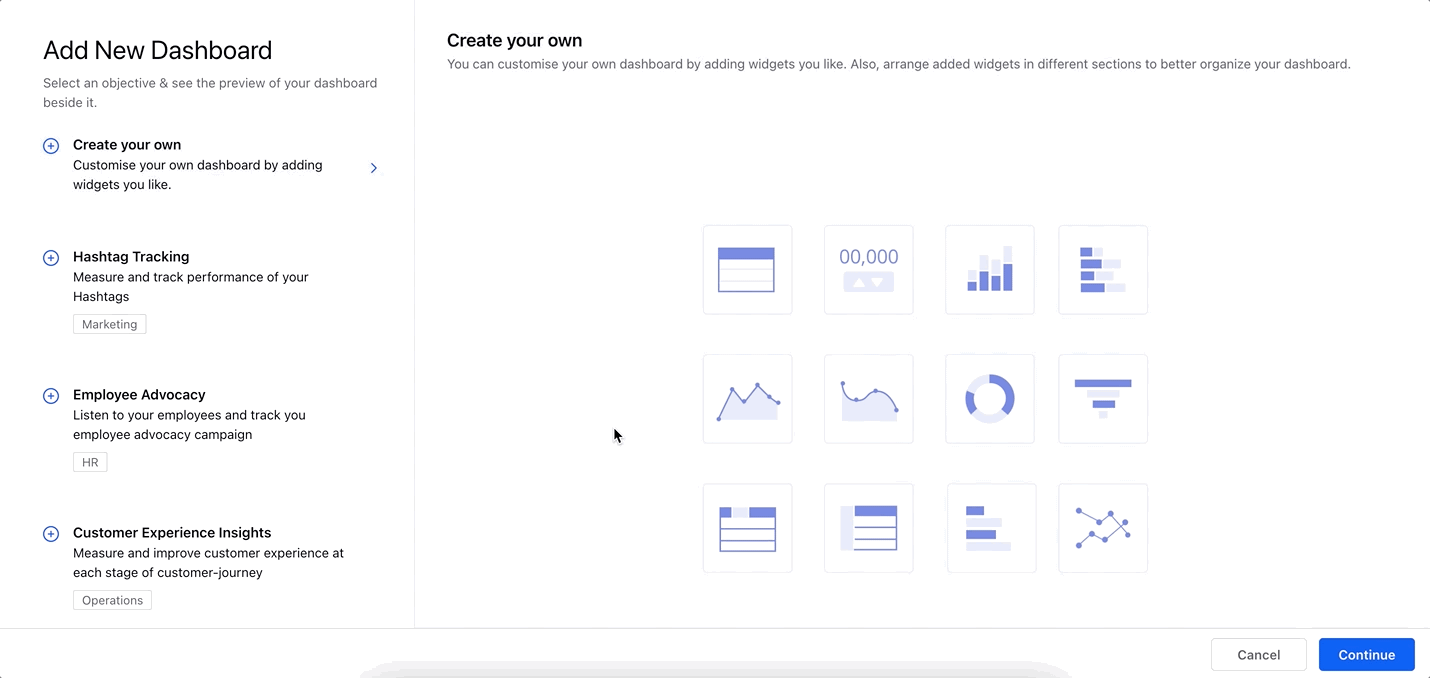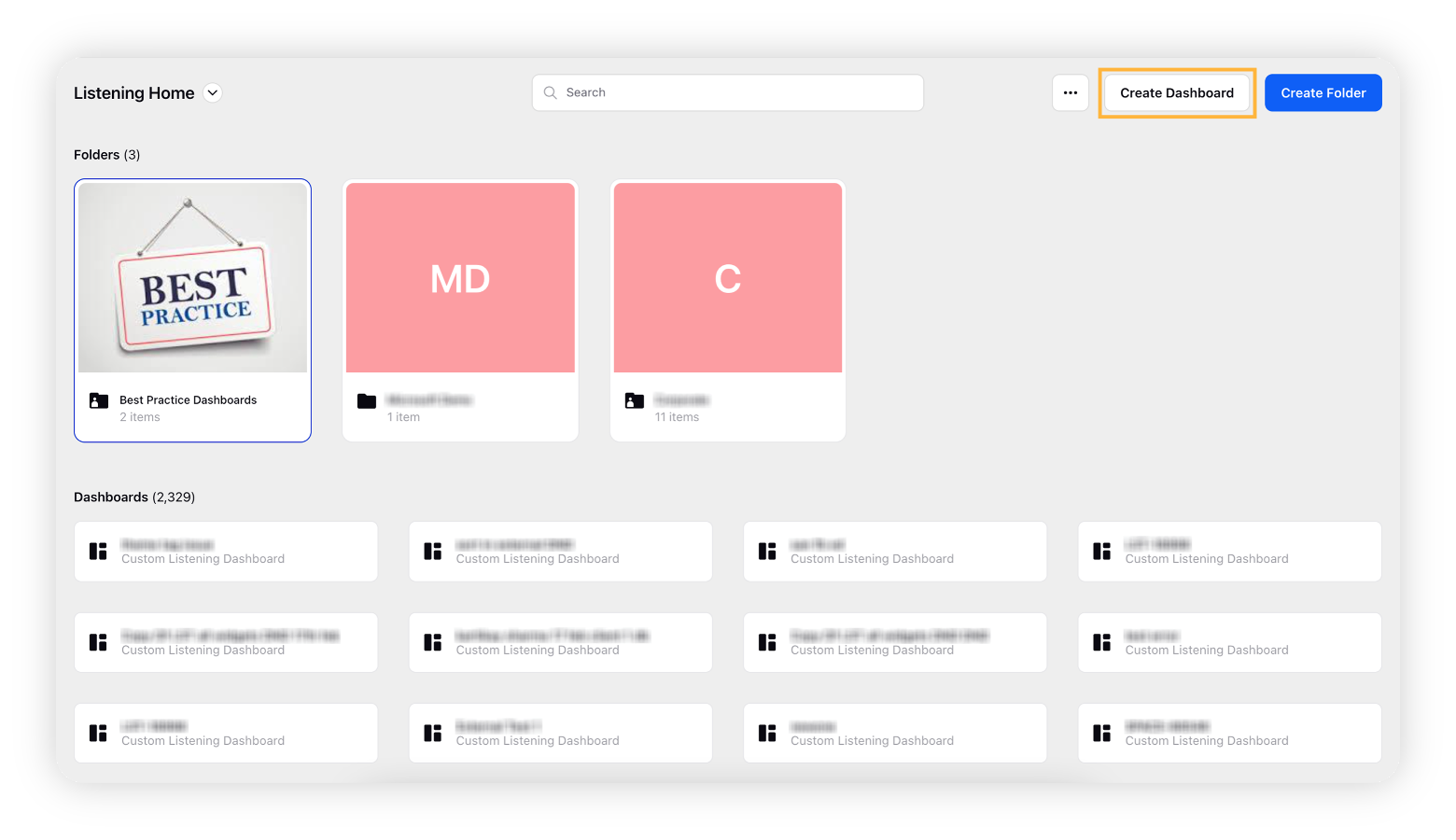Get familiar with all Listening Use-case dashboards and their objectives
Updated
In this article, you will learn about the various Use-case dashboards available in Social Listening and what their objectives are so you can choose the right dashboard that suits your business requirements.
In addition to the standard Listening dashboards , Social Listening comes with various pre-added Use-case Dashboards. Use-case dashboards are ready-to-use dashboards, and they are built inside the platform with multiple use cases. These dashboards are customized for 11 industries where you will find common use cases specific to both business functions and industry verticals. These pre-configured use case dashboards are good launching pads or starter templates for the Brands to leverage listening for multiple use cases.
UI of Use-case dashboard

To find the overview of use case dashboard in details, click here.
Difference between Standard dashboard and Use-case dashboard
Standard Dashboard | Use-case Dashboard |
Overall Listening insights to the brand | Business-focused actionable insights for the brand |
Macro-level analysis | Micro-level reporting like attributes, Hashtags, UGC, audience analysis |
Standard Dashboard is non-editable | Use-case Dashboards are editable. You can change all the aspects of the dashboard even at the widget level |
There is no storytelling | Storytelling exists |
Widgets are direct and to the point | Widgets are built from an analysis point of view. They drive actionable insights |
Standard dashboard are across all industries and business functions | Customized for industries and business domains |
Standard dashboards do not utilize any themes | Use-case dashboards are powered by industry-specific themes |
Available use cases and industries
Available Use Case | Available Industries | Business Function | Description |
Customer Care | Restaurants Airlines Telecom Apparel Retail Bank Automobile Laptop Multi-category Retail Store Insurance Smartphone Hotel | Customer Service | Identify your major Customer Care issues |
Influencer Measurement | Apparel Laptop | Marketing | Track the most important conversations of your influencers |
User-Generated Content | Apparel | Marketing | Identify the most popular User-generated content for different aspects of your brand |
Know your Audience | Generic | Consumer Insights | Understand the profile and demographics of your audience |
Employee Advocacy | Apparel Laptop | HR (Human Resource) | Listen to your employees and track the employee advocacy campaign |
Brand Health | Restaurants Airlines Telecom Apparel Retail Bank Automobile Laptop Multi-category Retail Store Insurance Smartphone Hotel | Marketing | Capture Brand Awareness, Brand Positioning and Brand Delivery for your brand versus competitors |
Product Innovation | Smartphone | Research and Development | Analyze what is happening latest in your industry |
Hashtag Tracking | Generic | Marketing | Measure and track the performance of your hashtag. |
Customer Experience Insights | Restaurants Airlines Telecom Apparel Retail Bank Automobile Laptop Multi-category Retail Store Insurance Smartphone Hotel | Operations | Measure and improve the customer experience at each stage of the customer journey |
Sentiment Analysis | Restaurants Airlines Telecom Apparel Retail Bank Automobile Laptop Multi-category Retail Store Insurance Smartphone Hotel | Consumer Insights | Measure and track sentiment and emotions for conversations |
Industry limitations
Industry | Limitations |
Restaurants | This industry entails to the food serving outlets like Quick Service Restaurant, fine dining restaurants, bakery, pubs, cafe's, fast-food joints and lounge formats. Note: Do not use it for individual products like soft drinks and eatables. |
Airlines | This industry covers the airline service providers. |
Telecom | This industry includes only telecommunication network providers. Telecom allies services are not considered. |
Apparel | This industry covers all kind of apparel manufacturers irrespective of the apparel line being manufactured. |
Retail Bank | This industry covers retail banks. The analysis is limited to the banking services available in retail customers. |
Automobile | These use-case dashboards are limited to four wheeler passenger cars. |
Laptop | This industry entails to only laptop hardware manufacturers and assemblers. |
Multi-Category Retail Store | This industry entails to multi-product line and multi-category retail formats. |
Insurance | This industry covers all type of insurance companies like Life Insurance, Car Insurance, Health Insurance, etc. |
Smartphone | This industry entails to only smartphone hardware manufacturers and assemblers. |
Hotel | This industry covers all hotels. |
Before you begin
Before you can start using a Use-case Dashboard, you must create Topics for your brand and competitors, choose Industry, and add Themes. (Use-case dashboards are powered by Themes.) To know about Best Practice to Use a Use-case Dashboards. click here.
To navigate to Use-case dashboard
Click the New Tab icon. Under the Sprinklr Insights tab, select Listening Dashboards within Learn.

On Listening Home, click the Create Dashboard button in the top right corner.

Select the desired Use-case dashboard from the left pane and click Continue.

Enter the Dashboard name, select the Topic for your brand, select topics for your competitors, choose your Industry, and select the Themes in case the use case (for e.g. Employee Advocacy) requires that field.

Click Create.
Once you have created the Use-case dashboard, you can edit it as per your requirements. Every use case dashboard is set up as a custom dashboard.
Making changes to the Use-case dashboard
You can change each and every aspect of the use case dashboard.
Within the Dashboards
You can change the visualization of any widget of the use case dashboard by using the edit widget option.
You can add more widgets to the use case dashboards.
You can delete any widget to the use case dashboards.
You can apply any filters like keyword lists, etc in dashboard level and widget level.
Changing the Topics in use-case dashboards
Topics are used as dashboard level filters and widget level filters in these dashboards. In case you need to change the topics, you can change at the dashboard level and the widget level filters.
Adding or deleting Themes to a widget
All themes created for use case dashboards pre-exit in the client environment and start with "spr"
You can add more themes to any widget.
Note:
First, you need to identify the corresponding theme tag by using the option to edit at the widget level. Then create the new theme and attach the identified theme tag to it.
You can delete theme from any widget.